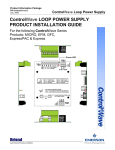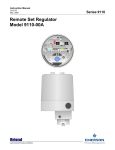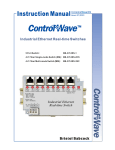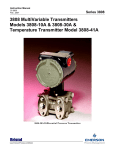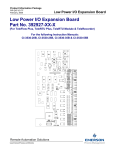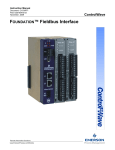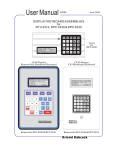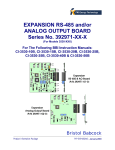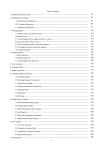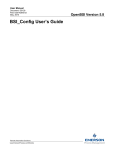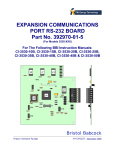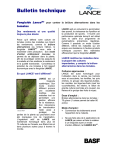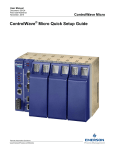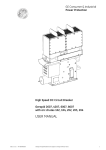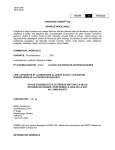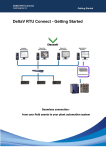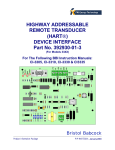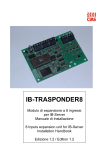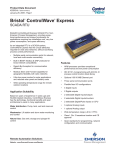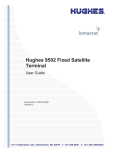Download PIP-EXPTIBTF - Welcome to Emerson Process Management
Transcript
Product Information Package PIP-EXPTIBTF Mar., 2007 TeleFlow Series 3530-10B/15B/20B/25B/35B/50B Expansion Transmitter Interface Board Part No. 392960-01-0 For The Following Bristol Instruction Manuals: CI-3530-10B, CI-3530-15B, CI-3530-20B, CI-3530-25B, CI-3530-35B & CI-3530-50B www.EmersonProcess.com/Bristol IMPORTANT! READ INSTRUCTIONS BEFORE STARTING! Be sure that these instructions are carefully read and understood before any operation is attempted. Improper use of this device in some applications may result in damage or injury. The user is urged to keep this book filed in a convenient location for future reference. These instructions may not cover all details or variations in equipment or cover every possible situation to be met in connection with installation, operation or maintenance. Should problems arise that are not covered sufficiently in the text, the purchaser is advised to contact Bristol for further information. EQUIPMENT APPLICATION WARNING The customer should note that a failure of this instrument or system, for whatever reason, may leave an operating process without protection. Depending upon the application, this could result in possible damage to property or injury to persons. It is suggested that the purchaser review the need for additional backup equipment or provide alternate means of protection such as alarm devices, output limiting, failsafe valves, relief valves, emergency shutoffs, emergency switches, etc. If additional in-formation is required, the purchaser is advised to contact Bristol . RETURNED EQUIPMENT WARNING When returning any equipment to Bristol for repairs or evaluation, please note the following: The party sending such materials is responsible to ensure that the materials returned to Bristol are clean to safe levels, as such levels are defined and/or determined by applicable federal, state and/or local law regulations or codes. Such party agrees to indemnify Bristol and save Bristol harmless from any liability or damage which Bristol may incur or suffer due to such party's failure to so act. ELECTRICAL GROUNDING Metal enclosures and exposed metal parts of electrical instruments must be grounded in accordance with OSHA rules and regulations pertaining to "Design Safety Standards for Electrical Systems," 29 CFR, Part 1910, Subpart S, dated: April 16, 1981 (OSHA rulings are in agreement with the National Electrical Code). The grounding requirement is also applicable to mechanical or pneumatic instruments that include electrically-operated devices such as lights, switches, relays, alarms, or chart drives. EQUIPMENT DAMAGE FROM ELECTROSTATIC DISCHARGE VOLTAGE This product contains sensitive electronic components that can be damaged by exposure to an electrostatic discharge (ESD) voltage. Depending on the magnitude and duration of the ESD, this can result in erratic operation or complete failure of the equipment. Read supplemental document S14006 at the back of this manual for proper care and handling of ESD-sensitive components. Bristol 1100 Buckingham Street, Watertown, CT 06795 Telephone (860) 945-2200 WARRANTY A. Bristol warrants that goods described herein and manufactured by Bristol are free from defects in material and workmanship for one year from the date of shipment unless otherwise agreed to by Bristol in writing. B. Bristol warrants that goods repaired by it pursuant to the warranty are free from defects in material and workmanship for a period to the end of the original warranty or ninety (90) days from the date of delivery of repaired goods, whichever is longer. C. Warranties on goods sold by, but not manufactured by Bristol, are expressly limited to the terms of the warranties given by the manufacturer of such goods. D. All warranties are terminated in the event that the goods or systems or any part thereof are (i) misused, abused or otherwise damaged, (ii) repaired, altered or modified without Bristol's consent, (iii) not installed, maintained and operated in strict compliance with instructions furnished by Bristol, or (iv) worn, injured or damaged from abnormal or abusive use in service time. E. THESE WARRANTIES ARE EXPRESSLY IN LIEU OF ALL OTHER WARRANTIES EXPRESS OR IMPLIED (INCLUDING WITHOUT LIMITATION WARRANTIES AS TO MERCHANTABILITY AND FITNESS FOR A PARTICULAR PURPOSE), AND NO WARRANTIES, EXPRESS OR IMPLIED, NOR ANY REPRESENTATIONS, PROMISES, OR STATEMENTS HAVE BEEN MADE BY BRISTOL UNLESS ENDORSED HEREIN IN WRITING. FURTHER, THERE ARE NO WARRANTIES WHICH EXTEND BEYOND THE DESCRIPTION OF THE FACE HEREOF. F. No agent of Bristol is authorized to assume any liability for it or to make any written or oral warranties beyond those set forth herein. REMEDIES A. Buyer's sole remedy for breach of any warranty is limited exclusively to repair or replacement without cost to Buyer of any goods or parts found by Seller to be defective if Buyer notifies Bristol in writing of the alleged defect within ten (10) days of discovery of the alleged defect and within the warranty period stated above, and if the Buyer returns such goods to Bristol's Watertown office, unless Bristol's Watertown office designates a different location, transportation prepaid, within thirty (30) days of the sending of such notification and which upon examination by Bristol proves to be defective in material and workmanship. Bristol is not responsible for any costs of removal, dismantling or reinstallation of allegedly defective or defective goods. If a Buyer does not wish to ship the product back to Bristol, the Buyer can arrange to have a Bristol service person come to the site. The Service person's transportation time and expenses will be for the account of the Buyer. However, labor for warranty work during normal working hours is not chargeable. B. Under no circumstances will Bristol be liable for incidental or consequential damages resulting from breach of any agreement relating to items included in this quotation, from use of the information herein or from the purchase or use by Buyer, its em-ployees or other parties of goods sold under said agreement. How to return material for Repair or Exchange Before a product can be returned to Bristol for repair, upgrade, exchange, or to verify proper operation, form (GBU 13.01) must be completed in order to obtain a RA (Return Authorization) number and thus ensure an optimal lead time. Completing the form is very important since the information permits the Bristol Repair Dept. to effectively and efficiently process the repair order. You can easily obtain a RA number by: A. FAX Completing the form (GBU 13.01) and faxing it to (860) 945-3875. A Bristol Repair Dept. representative will return call (or other requested method) with a RA number. B. E-MAIL Accessing the form (GBU 13.01) via the Bristol Web site (www.bristolbabcock.com) and sending it via E-Mail to [email protected]. A Bristol Repair Dept. representative will return E-Mail (or other requested method) with a RA number. C. Mail Mail the form (GBU 13.01) to Bristol Inc. Repair Dept. 1100 Buckingham Street Watertown, CT 06795 A Bristol Repair Dept. representative will return call (or other requested method) with a RA number. D. Phone Calling the Bristol Repair Department at (860) 945-2442. A Bristol Repair Department representative will record a RA number on the form and complete Part I, then send the form to the Customer via fax (or other requested method) for Customer completion of Parts II & III. A copy of the completed Repair Authorization Form with issued RA number should be included with the product being returned. This will allow us to quickly track, repair, and return your product to you. Bristol Repair Authorization Form (off-line completion) (Providing this information will permit Bristol to effectively and efficiently process your return. Completion is required to receive optimal lead time. Lack of information may result in increased lead times.) Date___________________ RA #___________________SH Standard Repair Practice is as follows: Variations to this is practice may be requested in the “Special Requests” section. • Evaluate / Test / Verify Discrepancy • Repair / Replace / etc. in accordance with this form • Return to Customer Part I Line No.____________ Please be aware of the Non warranty standard charge: • There is a $100 minimum evaluation charge, which is applied to the repair if applicable (√ in “returned” B,C, or D of part III below) Please complete the following information for single unit or multiple unit returns Address No. (office use only) Address No. (office use only) Bill to : Ship to: Purchase Order: Contact Name:____________________________________ Phone: Fax: Part II E-Mail: Please complete Parts II & III for each unit returned Model No./Part No. Description Range/Calibration S/N Reason for return: 1. Failure Upgrade Verify Operation Other Describe the conditions of the failure (Frequency/Intermittent, Physical Damage, Environmental Conditions, Communication, CPU watchdog, etc.) (Attach a separate sheet if necessary) 2. Comm. interface used: 3. What is the Firmware revision? _____________________ Standalone RS-485 Ethernet Other:______________ Modem (PLM (2W or 4W) or SNW) What is the Software & version? Part III If checking “replaced” for any question below, check an alternate option if replacement is not available A. If product is within the warranty time period but is excluded due to Bristol’s warranty clause, would you like the product: repaired returned replaced scrapped? B. If product were found to exceed the warranty period, would you like the product: repaired returned replaced scrapped? C. If product is deemed not repairable would you like your product: returned replaced scrapped? D. If Bristol is unable to verify the discrepancy, would you like the product: returned replaced *see below? * Continue investigating by contacting the customer to learn more about the problem experienced? The person to contact that has the most knowledge of the problem is: ______________________________ phone_____________________ If we are unable to contact this person the backup person is: _________________________ phone_____________________ Special Requests: ____________________________________________________________________________________ ____________________________________________________________________________________________________ Ship prepaid to: Bristol Inc., Repair Dept., 1100 Buckingham Street, Watertown, CT 06795 Phone: 860-945-2442 Fax: 860-945-2220 Form GBU 13.01 Rev. C 04/27/06 Bristol Training GET THE MOST FROM YOUR BRISTOL BABCOCK INSTRUMENT OR SYSTEM • Avoid Delays and problems in getting your system on-line • Minimize installation, start-up and maintenance costs. • Make the most effective use of our hardware and software. • Know your system. As you know, a well-trained staff is essential to your operation. Bristol Inc. offers a full schedule of classes conducted by full-time, professional instructors. Classes are offered throughout the year at three locations: Houston, Orlando and our Watertown, CT headquarters. By participating in our training, your personnel can learn how to install, calibrate, configure, program and maintain any and all Bristol products and realize the full potential of your system. For information or to enroll in any class, contact our training department in Watertown at (860) 945-2343. For Houston classes, you can also contact our Houston office, at (713) 6856200. A Few Words About Bristol Inc. For over 100 years, Bristol® has been providing innovative solutions for the measurement and control industry. Our product lines range from simple analog chart recorders, to sophisticated digital remote process controllers and flow computers, all the way to turnkey SCADA systems. Over the years, we have become a leading supplier to the electronic gas measurement, water purification, and wastewater treatment industries. On off-shore oil platforms, on natural gas pipelines, and maybe even at your local water company, there are Bristol Inc. instruments, controllers, and systems running year-in and year-out to provide accurate and timely data to our customers. Getting Additional Information In addition to the information contained in this manual, you may receive additional assistance in using this product from the following sources: Help Files / Release Notes Many Bristol software products incorporate help screens. In addition, the software typically includes a ‘read me’ release notes file detailing new features in the product, as well as other information which was available too late for inclusion in the manual. Contacting Bristol Inc. Directly Bristol's world headquarters is located at 1100 Buckingham Street, Watertown, Connecticut 06795, U.S.A. Our main phone numbers are: (860) 945-2200 (860) 945-2213 (FAX) Regular office hours are Monday through Friday, 8:00AM to 4:30PM Eastern Time, excluding holidays and scheduled factory shutdowns. During other hours, callers may leave messages using Bristol's voice mail system. Telephone Support - Technical Questions During regular business hours, Bristol's Application Support Group can provide telephone support for your technical questions. For technical questions about TeleFlow products call (860) 945-8604. For technical questions about ControlWave call (860) 945-2394 or (860) 945-2286. For technical questions regarding Bristol’s OpenEnterprise product, call (860) 945-3865 or e-mail: [email protected] For technical questions regarding ACCOL products, OpenBSI Utilities, UOI and all other software except for ControlWave and OpenEnterprise products, call (860) 945-2286. For technical questions about Network 3000 hardware, call (860) 945-2502. You can e-mail the Application Support Group at: [email protected] The Application Support Group maintains an area on our web site for software updates and technical information. Go to: www.bristolbabcock.com/services/techsupport/ For assistance in interfacing Bristol hardware to radios, contact Bristol’s Communication Technology Group in Orlando, FL at (407) 629-9463 or (407) 629-9464. You can e-mail the Communication Technology Group at: [email protected] Telephone Support - Non-Technical Questions, Product Orders, etc. Questions of a non-technical nature (product orders, literature requests, price and delivery information, etc.) should be directed to the nearest sales office (listed on the rear cover of this manual) or to your Bristol-authorized sales representative. Please call the main Bristol Inc. number (860-945-2200) if you are unsure which office covers your particular area. Visit our Site on the World Wide Web For general information about Bristol Inc. and its products, please visit our site on the World Wide Web at: www.bristolbabcock.com Training Courses Bristol’s Training Department offers a wide variety of courses in Bristol hardware and software at our Watertown, Connecticut headquarters, and at selected Bristol regional offices, throughout the year. Contact our Training Department at (860) 945-2343 for course information, enrollment, pricing, and scheduling. PIP-EXPTIBTF EXPANSION TRANSMITTER INTERFACE BOARD PT. Number 392960-01-0 Product Information Package TABLE OF CONTENTS SECTION TITLE PAGE # Section 1 - INTRODUCTION 1.1 1.1.1 1.2 1.3 DESCRIPTION .................................................................................................... 1 Transmitter Operation ........................................................................................ 1 Features................................................................................................................ 2 JUMPER JP1 ....................................................................................................... 2 Section 2 – INSTALLATION & SERVICE 2.1 2.1.1 2.1.1.1 2.1.1.2 2.1.1.3 2.2 2.2.1 2.2.1.1 2.2.1.2 2.2.1.3 REMOVAL/REPLACEMENT & INSTALLATION OF THE ETIB................... 3 Removal/Replacement of the Expansion Transmitter Interface Board ............ 3 Installation/Removal for Models 3530-10B, -15B & -50B.................................. 3 Installation/Removal for Models 353-20B & -25B............................................ 10 Installation/Removal for Model 3530-35B ........................................................ 12 FIELD WIRING ................................................................................................. 13 Terminal Connections........................................................................................ 14 Terminal Connections for Model 3808 Transmitters....................................... 14 Terminal Connections for a single Model 3508 Transmitter........................... 14 Trminal Connections for two Model 3508 Transmitters.................................. 15 Section 3 - SPECIFICATIONS 3.1 3.2 GENERAL SPECIFICATION ........................................................................... 17 ENVIRONMENTAL SPECIFICATIONS ......................................................... 17 SUPPLEMENTS Special Instructions for Class I, Division 2 Hazardous Locations...........................Appendix A PIP-EXPTIBTF Page 0-1 Table Of Contents Section 1 INTRODUCTION 1.1 DESCRIPTION Expansion Transmitter Interface Boards (ETIBs) allow up to two (2) Bristol, Series 3508 or Series 3808 Transmitters to communicate with an ACCOL loaded host TeleFlow or TeleFlow Plus Electronic Gas Measurement Computer (EGMC) (3530-10B/20B), a TeleRTU, TeleRTU Plus or TeleRTU Module (3530-15B/25B/35B) or a TeleFlow Corrector (3530-50B). The TeleFlow EGMC/RTU/Corrector polls and stores data from each transmitter and communicates with the network. The ETIB Board interfaced to a TeleFlow/TeleRTU CPU Board via the CPU Board’s Expansion Connector. Power from and communication with the host CPU Board is supplied through the Expansion Connector. ETIB Boards contain one jumper (JP1) for configuration. 1.1.1 Transmitter Operation 3508 Series Each Model 3508 Transmitter must be assigned a unique address via the SMARTKIT program as described in Section 4.2 PROGRAM LOADING AND STARTUP of the appropriate 3508 Transmitter manual. Additionally, all Model 3508 Transmitters wired to the TI Board must be operated in the minimum current mode (3.8 mA). This mode is selected via the SMARTKIT program as described in Section 4.7 TRANSMITTER OPERATING MODES of the appropriate 3508 Transmitter manual, i.e., CI-3508-10C, CI3508-30C or CI-3508-99C. Figure 1 - Transmitter Interface Board P/N 392960-01-0 PIP-EXPTIBTF Page 1 Expansion TIB Option 3808 MVT Series Each Model 3808 MVT Transmitter must be assigned a unique address via the WebBSI Sign On/Off Menu (see Section 3 of Customer Instruction Manual CI-3808). Additionally, only analog versions of the 3808 MVT can be interfaced to a Transmitter Interface Board. 1.1.2 Features • ESD & Transient Susceptibility Field connected circuitry has been designed to meet the requirements of IEC 801-2 for ESD withstand capability up to 10KV and the requirements of ANSI/IEEE C37.90.1-1989 (formerly IEE 472) for surge withstand capability. • EMI Compatibility ETIB Boards have been designed to coexist inside a shielded enclosure with the TeleFlow™ electronics. EMI radiation is insignificant and susceptibility is comparable or superior to associated electronics. • Mounting The ETIB Board measures 3.75” (9.525cm) in width x 4.0” (10.160cm) in height and mounts piggy-back on a TeleFlow or TeleRTU CPU Board. 1.2 JUMPER JP1 Jumper JP1 is used to configure the ETIB for operation with one or two 3508/3808 Transmitters. If only one 3508/3808 Transmitter is to be connected to the ETIB, Jumper JP1 must be installed across JP1-1 and JP1-2. Additionally, when only one 3508/3808 Transmitter is to be connected to the ETIB, it must be connected to connector TB1. When two 3508/3808 Transmitters are connected to the ETIB, Jumper JP1 must be removed and stored in either JP1-1 or JP1-2. Expansion TIB Option Page 2 PIP-EXPTIBTF Section 2 INSTALLATION & SERVICE 2.1 REMOVAL/REPLACEMENT & INSTALLATION OF THE ETIB 2.1.1 Removal/Replacement of the Expansion Transmitter Interface Bd. An installed ETIB option will contain the following parts: 1. Expansion Transmitter Interface Board (ETIB) (with removable Terminal Blocks) 2. Three #4-40 x 15/32” Standoffs (Note: Models 3530-10B, -15B & -50B will also contain Three (3) #4-40 x .188” Standoffs & Two (2) #4-40 x 1/8” SEM Screws) 3. Modified PC Shield Assembly (for models 3530-10B, -15B & -50B) WARNING Never attempt to service a TeleFlow or TeleRTU while it is powered and operating in a hazardous environment. Either the area must be made safe or the unit must be powered down, unwired, unmounted, and taken to a safe, non-hazardous area. WARNING Never attempt to install or remove any components (PCBs, Field Wiring, Transducers, etc.) while the unit is powered and running. Doing so can cause sudden electrical transients or imbalances that are capable of causing damage to the module or component in question, as well as other associated circuit boards. Always turn off the external/internal power source, including any additional supply sources used for externally-powered I/O circuits, before changing or adding any components. CAUTION Place any related critical processes under manual or auxiliary control prior to shutting down or performing any of the steps discussed herein. 2.1.1.1 Installation/Removal for Models 3530-10B, -15B & -50B To install the optional ETIB option into a model 3530-10B, -15B or -50B, follow steps 1 through 13 below. To remove the optional ETIB Board, see step 14. Note: The Instrument Front Cover must be open. 1. To open the Instrument Front Cover, remove the lock if present and turn each of the three captive screws a quarter (1/4) turn counterclockwise. PIP-EXPTIBTF Page 3 Expansion TIB Option Note: The CPU Board is not to be removed under any circumstances unless the unit has been moved to an ESD safe area (see ESDS Manual - S14006). 2. Remove the Power Plug(s), Solar Panel Power Plug, and the Auxiliary Power Plug as required, from the CPU Board in question. 3. Remove the optional radio or modem if installed. To remove an optional modem: Disconnect the phone wires. Loosen the four (4) screws that secure the Modem/Radio Mounting Plate (with modem) to the Battery Mounting Bracket. Slide the modem to the left and remove it and then disconnect the D-Type connector from the modem. To remove an optional radio: Disconnect the Radio/TeleFlow Interface Cable from the bottom of the Radio. Unplug the 2-wire power connector associated with the 2-wire Radio Power Interface Cable from the bottom of the Radio. Loosen the four (4) screws that secure the Modem/Radio Mounting Plate (with radio) to the Battery Mounting Bracket. Slide the radio to the left and remove it. 4. Remove the Battery(s) (if present). To remove the battery(s) from units without an optional modem or radio: Hold the battery securely and remove the Left Battery Mounting Bracket (secured with 2 screws. Loosen the screws which secure the Right Battery Mounting Bracket (Carefully remove the battery (with wiring harness). Remove the Right Battery Mounting Bracket. To remove the battery(s) from units with an optional modem or radio: Carefully remove the battery (with wiring harness). Note: You may have to loosen the two left 1/4-20 x 3/8” screws that secure the left side of the Battery Mounting Bracket and the Main Mounting Bracket to the rear of the unit. While holding the Main Mounting Bracket, remove the four (4) 1/4-20 x 3/8” screws and lock washers that secure the Battery Mounting Bracket and Main Mounting Bracket to the rear of the unit. Remove the Battery Mounting Bracket and temporarily reinstall the four screws to secure the Main Mounting Bracket to the 3530-10B or 3530-15B. 5. Disconnect the Local Port, Network Port, RTD, and Field I/O wires from the CPU Board connectors by unplugging their associated Terminal Plugs (front edge of CPU). 6. Carefully remove the PC Shield which is secured to the Main Mounting Bracket by 2 (#4-40 x 1/4”) screws and to the CPU Board by 2 (#4-40 x 1/4”) screws. 7. Remove the screw (location ‘A’ in Figures 2 & 3) and the two (2) #4-40 x 5/8” Standoffs (location ‘B’ in Figures 2 & 3) which secure the CPU Board to the Main Mounting Bracket. Replace these items with the three new #4-40 x 15/32” Standoffs. Note: This operation should only be performed in an ESD safe area. 8. Align the ETIB Board Connector P1 with CPU Board Connector J4 (for 3530-10B) or J18 (for 3530-15B). Push the EXPCOM232 Board toward the CPU Board until Connector P1 is fully seated. Expansion TIB Option Page 4 PIP-EXPTIBTF Figure 2 - TeleFlow CPU Board – Installation Drawing #1 9. Secure the ETIB Board to the CPU Board by installing three (3) #4-40 x .188” Standoffs at Locations ‘A’ & ‘B’ (see Figures 2 & 3). 10. Carefully install the Modified PC Shield, securing it to the Main Mounting Bracket (at locations ‘C’) with two (2) #4-40 x 1/4” screws and to the CPU Board (at locations ‘B’) with two (2) #4-40 x 1/8” SEM screws (see Figures 4, 5, 6 & 7). 11. Follow steps 2 through 6 in reverse order, replacing rather than removing the item in question. PIP-EXPTIBTF Page 5 Expansion TIB Option 12. Install 3508/3808 Transmitter wiring to the ETIB Board (see Section 2.2.1). Wiring should be routed through a ¾” conduit fitting (user installed) on the bottom of the enclosure. Figure 3 - TeleRTU CPU Board – Installation Drawing #1 13. Close and secure the Instrument Front Cover. 14. To remove an optional ETIB Board, follow steps 1 through 6 (unplug the Field Wiring Terminals during step 5). Remove the PC Shield along with the three Standoffs that Expansion TIB Option Page 6 PIP-EXPTIBTF secure the ETIB Board to the CPU Board. Then unplug the ETIB Board from the CPU Board in question. Figure 4 - TeleFlow CPU Board (with ETIB Installed) Installation Drawing #2 PIP-EXPTIBTF Page 7 Expansion TIB Option Figure 5 - TeleRTU CPU Board (with ETIB Installed) Installation Drawing #2 Expansion TIB Option Page 8 PIP-EXPTIBTF Figure 6 - 3530-10B & 3530-50B (with ETIB Installed) Figure 7 - 3530-15B (with ETIB Installed) PIP-EXPTIBTF Page 9 Expansion TIB Option 2.1.1.2 Installation/Removal for Models 3530-20B & -25B To install the optional ETIB Board into a model 3530-20B or 3530-25B, follow steps 1 through 10 below. To remove the optional ETIB Board, perform steps 1 and 2 and then follow steps 4 through 9 in reverse order, removing rather than installing the item in question after the system has been shut down. Note: The Instrument Front Cover must be open. 1. Open the Instrument Front Cover 2. Disconnect power by removing harness connector plug (P8 for TeleFlow - P2 for TeleRTU) from the CPU Board edge connector (J8 for TeleFlow - J2 for TeleRTU). Figure 8 - 3530-20B CPU (with ETIB Installed) Expansion TIB Option Page 10 PIP-EXPTIBTF 3. Unplug the remaining removable Terminal Blocks (with wiring harnesses installed) from the CPU Board’s front edge connectors. 4. Remove the two screws that secure the CPU Board’s Sliding Mounting Bracket to the Fixed Bracket on the bottom of the Battery Bracket. Carefully slide the CPU Board (and optional ETIB Board) toward the front of the unit. Remove harness connections from the Front Panel Switch (J12 on the TeleFlow CPU - J14 on TeleRTU CPU), the Display Module (J2 on TeleFlow CPU - J16 on TeleRTU CPU), the Wakeup Switch (J3 on TeleFlow CPU - J16 on TeleRTU CPU), and for TeleFlow CPU Boards connector J1 (associated with the Multivariable Transducer). Figure 9 - 3530-25B CPU (with ETIB Installed) 5. Remove the three screws (of five) that secure the CPU Board to the Sliding Mounting Bracket (locations ‘A’ & ‘B’ in Figures 2 & 3) and replace these items with the three new #4-40 x 15/32” Standoffs. PIP-EXPTIBTF Page 11 Expansion TIB Option Note: This operation should only be performed in an ESD safe area. 6. Align the ETIB Board Connector P1 with CPU Board Connector J4 (for 3530-20B) or J18 (for 3530-25B). Push the ETIB Board toward the CPU Board until Connector P1 is fully seated. 7. Secure the ETIB Board to the CPU Board by installing three (3) #4-40 x 1/4” SEM screws as illustrated in Figures 8 & 9. 8. Install 3508/3808 Transmitter wiring to the ETIB Board (see Section 2.2.1). Wiring should be routed through a ¾” conduit fitting (user installed) on the bottom of the enclosure. 9. Close and secure the Instrument Front Cover. 2.1.1.3 Installation/Removal for Models 3530-35B To install the optional ETIB Board into a model 3530-35B, follow steps 1 through 7 below. To remove the optional ETIB Board, perform step 1 and then follow steps 5 through 7 in reverse order, removing rather than installing the item in question after the system has been shut down. 1. Disconnect power by removing harness connector plug P2 from the CPU Board edge connector J2. 2. Unplug the remaining removable Terminal Blocks (with wiring harnesses installed) from the CPU Board’s front edge connectors. 3. Remove harness connections from the Front Panel Switch (J14), the Display Module (J16) and the Wakeup Switch (J16). 4. Remove the three screws (of five) that secure the CPU Board to the RTU Mounting Bracket (locations ‘A’ & ‘B’ in Figures 2 & 3) and replace these items with the three new #4-40 x 15/32” Standoffs. Note: This operation should only be performed in an ESD safe area. 5. Align the ETIB Board Connector P1 with CPU Board Connector J18. Push the ETIB Board toward the CPU Board until Connector P1 is fully seated. 6. Secure the ETIB Board to the CPU Board by installing three (3) #4-40 x 1/4” SEM screws as illustrated in Figure 10. 7. Install 3508/3808 Transmitter wiring to the ETIB Board (see Section 2.2.1). Expansion TIB Option Page 12 PIP-EXPTIBTF Figure 10 - 3530-35B (with ETIB Installed) 2.2 FIELD WIRING The device uses compression-type terminals that accommodate up to #14 AWG wire. A connection is made by inserting the bared end (1/4 inch Max.) into the clamp beneath the screw and then securing the screw. Insert the bared end fully to prevent short circuits. Allow some slack in the wires when making terminal connections. The slack makes the connections more manageable and minimizes mechanical strain on the printed circuit boards and harnesses. PIP-EXPTIBTF Page 13 Expansion TIB Option 2.2.1 Terminal Connections 2.2.1.1 Terminal Connections for Model 3808 Transmitters ETIB Boards contain two terminal blocks that are used to provide field wiring connections to up to two Model 3808 Transmitters. TB1 & TB2 are two-position Terminal Blocks which connect to the signal/power inputs of the Transmitters. JP1 Note: If only one Transmitter is connected to the ETIB, Jumper JP1 must be INSTALLED across JP1-1 & JP1-2. When two Transmitters are connected to the ETIB, Jumper JP1 must be REMOVED. Store the Jumper on Jumper Post JP1-1 or JP1-2. Note: When only one Transmitter is connected to the ETIB, it MUST BE connected to TB1. Figure 11 - Internally Powered Model 3808 Transmitters - Field Wiring Diagram ETIB Boards may be connected to up to two internally powered Model 3808 Transmitters. Connection to internally powered Model 3808 Transmitters (powered from ETIB’s on-board +12V Supply/Regulator) is illustrated in Figure 11. 2.2.1.2 Terminal Connections for a single Model 3508 Transmitter The two-position Terminal Block TB1 is utilized to provide field wiring connections to an internally powered Model 3508 Transmitter. Expansion TIB Option Page 14 PIP-EXPTIBTF JP1 Note: Jumper JP1 must be INSTALLED across JP1-1 & JP1-2. Figure 12 - Internally Powered Model 3508 Transmitter - Field Wiring Diagram Connection to an internally powered Model 3508 Transmitter (powered from the ETIB’s onboard Supply/Regulator) is illustrated in Figure 12. 2.2.1.3 Terminal Connections for two Model 3508 Transmitters ETIB Boards contain two terminal blocks that are used to provide field wiring connections for up to two Model 3508 Transmitters. TB1 & TB2 are two-position Terminal Blocks which connect to the signal/power inputs of the Transmitters. When using two Model 3508 Transmitters, an external 21 Volt (dc) power supply must be utilized (see Figure 13). PIP-EXPTIBTF Page 15 Expansion TIB Option JP1 Note: Jumper JP1 must be REMOVED. Store the Jumper on Jumper Post JP1-1 or JP1-2. TeleFlow CPU Connector J5-5 TeleRTU CPU Connector J6-2 GND External 21V Power Supply Figure 13 - Externally Powered Model 3508 Transmitters - Field Wiring Diagram Expansion TIB Option Page 16 PIP-EXPTIBTF Section 3 SPECIFICATIONS 3.1 GENERAL SPECIFICATIONS Communication Interface: RS-232 (± 3V minimum) 3508/3808 Interface: FSK Modem - Bell 202 Compatible (1200 Hz/2200 Hz modulation) Baud rate is 1200 ESD Susceptibility: Field connected circuits are designed to meet the requirements of IEC 801-2 for ESD withstand capability up to 10KV. EMI Compatibility: Designed to coexist within a shielded enclosure with the TeleFlow (3530-10/20B) or the TeleRTU (3530-15B/25B) electronics. EMI radiation is insignificant and susceptibility is comparable or superior to associated electronics. Transient Susceptibility: Field connected circuits are designed to meet the requirements of ANSI/IEEEC37.90-1998 (Formerly IEEE 472) for surge withstand capability. 3.2 ENVIRONMENTAL SPECIFICATIONS Operating Temperature: -40°C to +60°C (-40°F to +140°F) Storage Temperature: -40°C to +85°C (-40°F to +185°C) Relative Humidity: 15% - 90% Non-condensing Vibration: 1G for 10Hz to 500Hz per SAMA PMC-31-1 (without damage or impairment) PIP-EXPTIBTF Page 17 Expansion TIB Option Expansion Transmitter Interface Board Special Instructions for Class I, Division 2 Hazardous Locations 1. The Bristol Expansion Transmitter Interface Board (ETIB) is listed by Underwriters Laboratories (UL) as nonincendive and is suitable for use in Class I, Division 2, Groups A, B, C and D hazardous locations or non-hazardous locations only. Read this document carefully before installing a nonincendive Britol ETIB Board. In the event of a conflict between the ETIB Board User Manual (PIP-EXPTIBTF) and this document, always follow the instructions in this document. 2. Wiring must be performed in accordance with Class I, Division 2 wiring methods as defined in Article 501-4 (b) of the National Electrical Code, NFPA 70 for installations within the United States, or as specified in Section 18-152 of the Canadian Electrical Code for installation in Canada. 3. WARNING: EXPLOSION HAZARD - Substitution of components may impair suitability for use in Class I, Division 2 environments. 4. WARNING: EXPLOSION HAZARD - When situated in a hazardous location, turn off power before servicing/replacing the unit and before installing or removing I/O wiring. 5. WARNING: EXPLOSION HAZARD - Do Not disconnect equipment unless the power has been switched off or the area is known to be nonhazardous. 03/14/2007 Appendix A of PIP-EXPTIBTF - ETIB Board Page 1 of 1 Expansion Transmitter Interface Board Part No. Emerson Process Management Bristol, Inc. 1100 Buckingham Street Watertown, CT 06795 Phone: +1 (860) 945-2262 Fax: +1 (860) 945-2525 www.EmersonProcess.com/Bristol Emerson Electric Canada, Ltd. Bristol Canada 6338 Viscount Rd. Mississauga, Ont. L4V 1H3 Canada Phone: 905-362-0880 Fax: 905-362-0882 www.EmersonProcess.com/Bristol Emerson Process Management BBI, S.A. de C.V. Homero No. 1343, 3er Piso Col. Morales Polanco 11540 Mexico, D.F. Mexico Phone: (52-55)-52-81-81-12 Fax: (52-55)-52-81-81-09 www.EmersonProcess.com/Bristol Emerson Process Management Bristol Babcock, Ltd. Blackpole Road Worcester, WR3 8YB United Kingdom Phone: +44 1905 856950 Fax: +44 1905 856969 www.EmersonProcess.com/Bristol Emerson Process Management Bristol, Inc. 22 Portofino Crescent, Grand Canals Bunbury, Western Australia 6230 Mail to: PO Box 1987 (zip 6231) Phone: +61 (8) 9725-2355 Fax: +61 (8) 8 9725-2955 www.EmersonProcess.com/Bristol Product Information Package PIP-EXPTIBTF 392960-01-0 Mar., 2007 The information in this document is subject to change without notice. Every effort has been made to supply complete and accurate information. However, Bristol, Inc. assumes no responsibility for any errors that may appear in this document. If you have comments or questions regarding this manual, please direct them to your local Bristol sales representative, or direct them to one of the addresses listed at left. Bristol, Inc. does not guarantee the accuracy, sufficiency or suitability of the software delivered herewith. The Customer shall inspect and test such software and other materials to his/her satisfaction before using them with important data. There are no warranties, expressed or implied, including those of merchantability and fitness for a particular purpose, concerning the software and other materials delivered herewith. TeleFlow™ is a trademark of Bristol, Inc. The Emerson logo is a trade mark and service mark of Emerson Electric Co. Other trademarks or copyrighted products mentioned in this document are for information only, and belong to their respective companies, or trademark holders. Copyright (c) 2007, Bristol, Inc., 1100 Buckingham St., Watertown, CT 06795. No part of this manual may be reproduced in any form without the express written permission of Bristol, Inc. This page provides links that allow you to return to a manual’s Table of Content (T.O.C) or return to the first page of the Main Menu. Links are provided by selecting the appropriate Link Text Box.





























